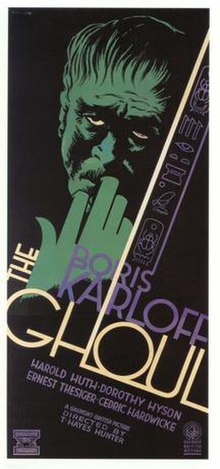The Ghoul (1933 film)
| The Ghoul | |
|---|---|
 |
|
| Directed by | T. Hayes Hunter |
| Produced by | Michael Balcon |
| Written by | Dr. Frank King (play) Rupert Downing Leonard Hines Roland Pertwee John Hastings Turner |
| Starring |
Boris Karloff Cedric Hardwicke Ernest Thesiger Ralph Richardson |
| Music by |
Louis Levy Leighton Lucas |
| Cinematography | Günther Krampf |
| Edited by |
Ian Dalrymple Ralph Kemplen |
|
Production
company |
|
| Distributed by | Woolf & Freedman Film Service |
|
Release date
|
August 1933 (UK) January 1934 (US) |
|
Running time
|
77 minutes |
| Country | United Kingdom |
| Language | English |
| Budget | just under ₤40,000 |
The Ghoul (1933) is a British horror film starring Boris Karloff, Cedric Hardwicke, Ernest Thesiger, and Ralph Richardson, making his film debut.
Gaumont British borrowed just the vaguest outline from the 1928 source novel by Frank King (and subsequent play by King and Leonard J. Hines). King's novel is sub-par Edgar Wallace in which a master criminal popularly referred to as 'The Ghoul' has been responsible for a London crime wave. Betty inherits an estate on the Yorkshire moors from a mysterious benefactor, Edward Morlant, a dabbler in mysticism who years before had been her mother's paramour. But the will requires Betty to take up residence in the old house, where Morlant's corpse soon appears, walking and talking. Morlant tells her that he is an immortal adept and demands the return of his secret diary. The usual suspects and interlopers converge on the house, and upon Morlant's next appearance his resurrected self is killed anew, unquestionably stabbed through the heart. Morlant is soon perambulating again, as people begin turning up dead. All supernatural trappings are dispelled as 'The Ghoul' is penultimately unmasked as Edward Morlant's twin brother, James, a criminal mastermind whose fictive guises included not only his brother, but a bogus police sergeant and his brother's solicitor, Broughton. In a final act of madness, James torches the mansion.
The film screenplay uses the merest skeleton of the story and characters and blends it with the Egyptian mysticism of The Mummy while capitalizing on the "thunderstorm mystery" mood of The Old Dark House (1932), Karloff's two previous Universal Pictures. Eccentric Egyptologist Professor Morlant believes that if he is buried with a jewel called "The Eternal Light", in a faux Egyptian tomb he has constructed at his English country estate, Anubis will manifest before him, accept his offering of the diamond, and grant him eternal life. Morlant appears to die, but the jewel is snatched by his servant before the interment. No sooner do the heirs arrive for the reading of the will, than Morlant rises from his tomb, finds his bauble gone, and attempts to punish the thieves. The jewel is punted from servant to lawyer to niece to Egyptian fanatic to spinster to mock vicar and eventually back to the revenant Morlant, who makes his blood sacrifice to Anubis before properly expiring. Morlant, it is learned, had merely suffered a cataleptic seizure, and had been buried alive. The mock vicar (Ralph Richardson) is revealed to be the chief villain, and having obtained the Eternal Light sets fire to Morlant's tomb. Betty and her lover manage to escape.
...
Wikipedia
